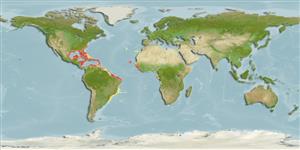Common names from other countries
Classification / Names / Names
Common names | Synonyms | Catalog of Fishes (gen., sp.) | ITIS | CoL | WoRMS
Environment: milieu / climate zone / depth range / distribution range
Ecology
Reef-associated; depth range 0 - 400 m (Ref. 98615). Tropical
Central Atlantic: Gulf of Mexico, Caribbean south to Brazil and into eastern Atlantic, Canary Island.
Length at first maturity / Size / Weight / Age
Maturity: Lm ? range ? - ? cm
Known to be rare at greater depths (Ref. 86574). Minimum depth from Ref. 83942. This is an epibenthic, subtidal species found in coral reefs and rocky bottoms (Ref. 83942). On coral reefs to a depth of 50 m, but common in shallow water (Ref. 415, 86574); and on Thalassiabeds (Ref. 86574). Nocturnal grazers (Ref. 415).
Life cycle and mating behavior
Maturity | Reproduction | Spawning | Eggs | Fecundity | Larvae
Spawning occurs during full moon (Ref. 98615).
Collin, R., M.C. Díaz, J. Norenburg, R.M. Rocha, J.A. Sánchez, M. Schulze, A. Schwartz and A. Valdés. 2005. (Ref. 415)
IUCN Red List Status (Ref. 130435)
CITES status (Ref. 108899)
Not Evaluated
Not Evaluated
Human uses
| FishSource |
Tools
More information
Age/SizeGrowthLength-weightLength-lengthMorphologyLarvaeAbundance
Internet sources
Estimates based on models
Preferred temperature
(Ref.
115969): 17.1 - 27.1, mean 23.3 (based on 157 cells).
Price category
Unknown.
